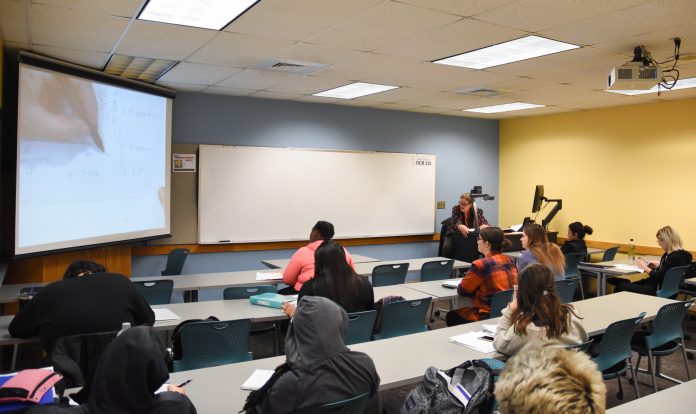
Caleb Latas
Staff reporter
As the leaves turn to hues of red, yellow and orange, some students might begin to notice that their classrooms, too, have turned. Classrooms across campus have turned from flat-white to pops of blue, yellow and green.
The project started nearly four years ago when Kathryn Grube, associate professor of interior design, presented her study on color psychology.
“I wrote my master’s thesis on [how in] all the schools, all the color in the school was only in the common areas like the cafeteria or the gyms or the lobby,” Grube said. “Every classroom you went into there were white walls. It’s been proven, that white walls cause anxiety and depression, students lose focus, it can cause off-task behaviors.
So far, in two years, 63 of the 270 classrooms and 124 labs on campus, have been painted in the new colors. Rex Hays, associate vice president for campus services and facilities planning, said the school has an annual budget of $50,000 for painting the classrooms. Hays said that’s roughly 33 to 35 classrooms a year.
“It’s been proven that changing the color of the wall actually influences behavior to make you more productive, to be more comforting, to promote focus, to relax anxiety,” Grube said. “More learning, academic scores go up.”
Preference or Psychology
It doesn’t matter if your favorite color is blue or green or a different color, Grube says that doesn’t play into the psychological aspect of color, and its advantages.
“The biggest misconception is that color is deemed as a preference only, and that it doesn’t have a function,” Grube said.
It’s not that the color blue is pretty so students pay more attention in class, it’s actually the scientific energy that reflects off the wall. The walls are blue because all the colors are absorbed from the white light, except for blue, and the blue is reflected off, that’s how the walls are perceived as blue.
“Color is that energy, that light is coming down and it actually absorbs into our skin. It’s not just an aesthetic,” Grube said. “That energy that is in there is actually going in our skin and our eyes. And it makes our body change psychologically and physiologically whether we know it or not.”
Ultimately though, the deans of each department decide on which colors, from Grube’s preselected palette, will be painted in their classrooms.
Blue, Yellow and Green
Grube said blue, yellow and green were chosen as the colors both for their psychological effects, but also to keep in theme with the school. Blue and yellow for the school’s colors, and then when the two are combined together they create green.
“Blue promotes focus, promotes attention, it actually lowers your respiration rates, lowers your heart rate, so it actually makes you calmer,” Grube said. “It suppresses appetite. It is excellent in certain classrooms too, because it is a cooler color. It can actually psychologically change the temperature of that room [to] 6 to 10 degrees cooler.”
Green was used because it’s a cool and relaxing color. Grube said that it works well with science type classrooms, and that when the green reflects, it can open up our oxygen and deepen breathing.
“Then we used yellow because it’s stimulating, it’s a warmer color,” Grube said. “Yellow creates an internal energy. It actually helps promote memory. It generates muscle energy. So it’s used in a lot of gymnasium settings. It’s stimulating so it helps with collaboration and discussion. It gives the sensation of heat and light.”
Grube’s research, the school and this project, will be nationally published this December, in the “School Planning and Management” magazine in their 2017 Educational Design Showcase edition.





















